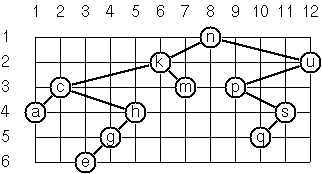Problem 64
To draw a tree a layout algorithm determines the position of each node in a rectangular grid. Several layout methods are conceivable, one of them is illustrated below:

In this layout strategy, the following two rules determine the position:
x(v)is equal to the position of the nodevin the inorder sequencey(v)is equal to the depth of the nodevin the tree.
Write a function to annotate each node of the tree with its position. To solve this problem you will need to traverse the tree. Problems 68a, 68b, and 68c examine tree traversal.
Example
tree64 =
Node 'n'
(Node 'k'
(Node 'c'
(Node 'a' Empty Empty)
(Node 'h'
(Node 'g'
(Node 'e' Empty Empty)
Empty)
Empty))
(Node 'm' Empty Empty))
(Node 'u'
(Node 'p'
Empty
(Node 's'
(Node 'q' Empty Empty)
Empty))
Empty)
layout tree64 ==
Node ('n',(8,1)) (Node ('k',(6,2)) (Node ('c',(2,3)) ...
Unit Test
import Html
import List
type Tree a
= Empty
| Node a (Tree a) (Tree a)
tree64 =
Node 'n'
(Node 'k'
(Node 'c'
(Node 'a' Empty Empty)
(Node 'h'
(Node 'g'
(Node 'e' Empty Empty)
Empty)
Empty))
(Node 'm' Empty Empty))
(Node 'u'
(Node 'p'
Empty
(Node 's'
(Node 'q' Empty Empty)
Empty))
Empty)
layout : Tree a -> Tree (a, (Int, Int))
layout tree =
-- your implementation here
Empty
main =
Html.text
(if (test) then
"Your implementation passed all tests."
else
"Your implementation failed at least one test."
)
test : Bool
test =
let
t = layout tree64
in
List.all ((==) True)
[ t == layout64
]
layout64 =
Node ('n', (8, 1))
(Node ('k', (6, 2))
(Node ('c', (2, 3))
(Node ('a', (1, 4)) Empty Empty)
(Node ('h', (5, 4))
(Node ('g', (4, 5))
(Node ('e', (3, 6)) Empty Empty)
Empty)
Empty))
(Node ('m', (7, 3)) Empty Empty))
(Node ('u', (12, 2))
(Node ('p', (9, 3))
Empty
(Node ('s', (11, 4))
(Node ('q', (10, 5)) Empty Empty)
Empty))
Empty)
Hints
- You can simplify the problem by breaking down into two or more steps, traversing once to set the X, once to set the Y. You can model
List.indexedMapto create traversal functions wtih depth or in-order. - The problem can be solved in a single traversal. You'll probably need nested
letclauses to get the in-order values from subtree traversals.